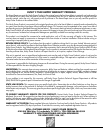
5
CHARGE RATE SELECTOR SWITCH
FIGURE 3
• The sliding selector switch on the front panel of the charger offers two Charge Rates for charging various
types of batteries and a Start position to assist starting engines.
• Select the correct switch position BEFORE connecting the charger to a battery or AC power source.
• Selections are made by sliding the switch into the correct position, corresponding with the type of battery
being charged, as follows:
FIGURE 4
S
ELECTOR
S
WITCH
P
OSITION
C
HARGING
R
ATE
LEFT 55 A
MP
S
TART
CENTER 10 A
MP
/12 V
OLT
DC C
HARGE
(
LARGER
BATTERIES
)
RIGHT 2 A
MP
/12 V
OLT
DC C
HARGE
(
SMALLER
BATTERIES
)
• Small 12 volt DC batteries such as those used in motorcycles, garden tractors, ATVs, jet skis, and
snowmobiles can be damaged by high rates of charge. ALWAYS select the 2 Amp/12 Volt setting (RIGHT
switch position) to charge this type of battery. For a slower charging time on larger batteries select the
2 Amp/12 Volt setting.
WARNING: IF IN DOUBT ABOUT SELECTING A CHARGE RATE, SELECT THE LOWER RATE. BATTERIES GET
WARM DURING CHARGING - IF BATTERIES ARE GETTING HOT, DISCONTINUE CHARGING AND
INVESTIGATE FOR DAMAGED BATTERY.
NOTE: The HSK074HD is a fully automatic battery charger, which only enables its output power if the terminal
voltage of the battery under charge is higher than 3V.
AMMETER AND INDICATORS
The ammeter is the colored (red, green and blue) chart on the front of the unit. It displays the current flowing from
the charger to the battery, in amperes. (See Figure 5)
The current when starting to charge a battery will depend on the battery's percent of charge. The actual current will
usually be lower than the current selected on the charger's switch, unless the battery is severely discharged. As the
battery charge level increases, the current reduces.
The ammeter is intended to show how the charging process is proceeding. It should not be used to determine the
level of battery charge - this should be done using a hydrometer or a voltmeter.
Typically 12.6 VDC is considered full charge on a 12 volt battery if the voltage is measured one hour after the
charger is disconnected. During charging, a nominal 12 volt battery can be 13.6 volts or somewhat higher, so it
needs to rest after charging to measure actual state of charge.
The charger's built-in battery full circuitry automatically taper charges the battery as it approaches full charge and
discontinues charging when the battery reaches full charge. When the battery is fully charged the
Charging Complete indicator lights. (See Figure 5B) Charging Complete indicator and Polarity indicator.
To the left of the Charging Complete indicator is an indicator that lights when incorrect polarity is sensed. It indicates
that the charger to battery connection is reversed and it must be corrected before charging can begin. This feature
only operates when at least 4 volts or higher voltage remains in the battery to be charged.
FIGURE 5A FIGURE 5B














